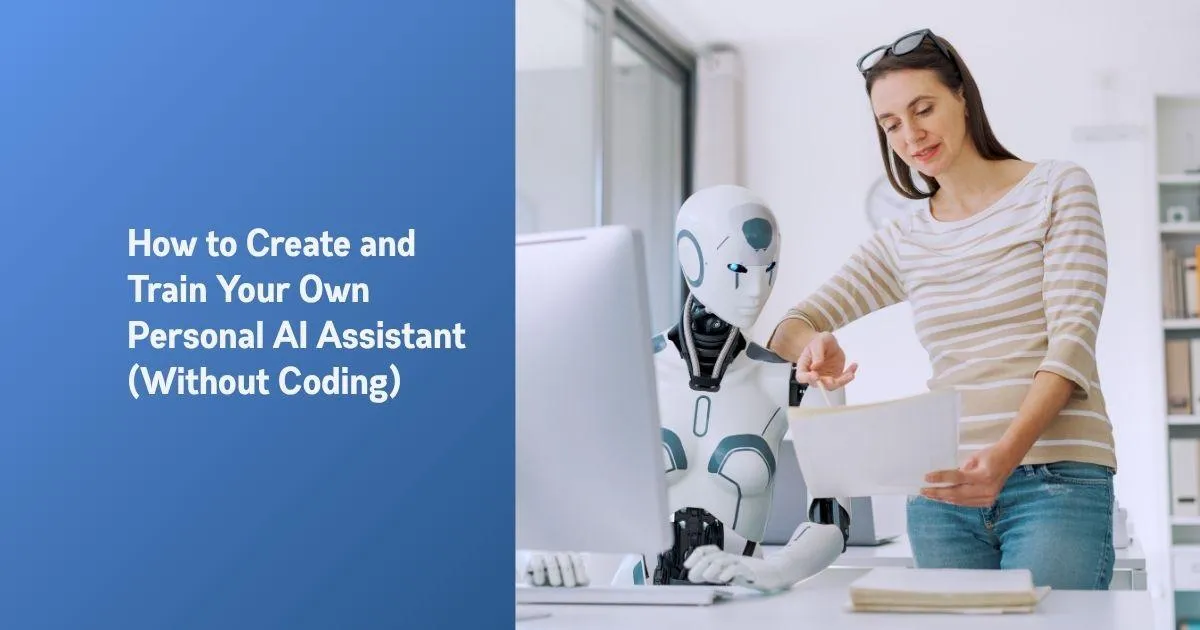
How to Create and Train Your Own Personal AI Assistant (Without Coding)
Can I create and train my own personal AI Assistant without coding? Yes! You absolutely can. Thanks to tools like ChatGPT Custom GPTs, Zapier AI agents, and Voiceflow, it's now possible to create and train your own personal AI assistant without writing a single line of code. You don’t need to be a developer, just someone with clear goals and the right tools.
If you’ve ever felt like off-the-shelf AI tools don’t think the way you do, you’re not alone. Most generic assistants are built to serve the masses, not you. They don’t reflect your brand tone, your workflow, or your business priorities.
As a member of PurelyStartup, where we help entrepreneurs and teams automate smartly using AI, I’ve seen firsthand how even non-tech folks can build custom AI assistants that handle real tasks from client communication to content planning and admin. And in this post, I’m going to show you exactly how.
By the end, you won’t just be using AI, you’ll be training it to think like you, work like you, and save you hours every week.
How to Create and Train Your Own Personal AI Assistant (Without Coding)
What Is a Personal AI Assistant and What Can It Actually Do?
Can AI be a personal assistant?
Real-World Things Your AI Assistant Can Do (Right Now)
Why Train Your Own AI Assistant Instead of Using Prebuilt Tools?
Prebuilt AI Tools vs. Training Your Own
What Are the Real Benefits of Training Your Own AI Assistant?
How to Train Your Own Personal AI Assistant [Step-by-Step Guide]
Step 1: Identify the Repetitive Tasks You Want to Delegate
Step 2: Choose the Right AI Assistant Platform for Your Use Case
Step 3: Define the Assistant’s Role and Boundaries
Step 4: Upload Data It Can Learn From
Step 5: Train Through Example Prompts and Conversations
Step 6: Test It with Real-World Tasks (Before Going All In)
Step 7: Connect It to Your Favorite Tools and Workflows
Step 8: Set a Maintenance Routine to Improve Performance Over Time
Quick Summary: How to Train Your Own Personal AI Assistant (Free + No Code)
Can You Train ChatGPT with Your Own Data?
How to Make Your AI Assistant Sound Like You (Not a Robot)
Prompt Engineering Tweaks That Change Everything
How to Keep Your AI Assistant Updated and Performing Well
Monthly AI Assistant Review Checklist
Add New Data and Examples as Your Business Grows
What Is a Personal AI Assistant and What Can It Actually Do?
A personal AI assistant is a digital tool powered by artificial intelligence that helps automate and manage tasks like answering questions, scheduling events, creating content, summarizing documents, and even handling customer support, all based on your unique instructions or data.
Can AI be a personal assistant?
Absolutely. AI can act as a highly personalized assistant, learning your tone, remembering context, and automating everyday tasks without the need for human input. Tools like ChatGPT, Zapier AI agents, and ElevenLabs are already being used to power AI assistants for content creators, solopreneurs, marketers, and CEOs.
But let’s clear up the confusion: not all AI assistants are the same.
Real-World Things Your AI Assistant Can Do (Right Now)
Draft and repurpose social media posts
Reply to customer DMs or emails
Summarize long documents or transcribe calls
Schedule calendar events or reminders
Categorize and tag content
Generate blog outlines or SEO meta descriptions
Create onboarding instructions for new clients
And yes! It can do these things your way, not just the “default” AI way. With a little training, your assistant can learn your preferences, tone, and priorities.
Zapier’s 2024 AI automation report found that over 61% of small businesses now use AI tools to handle admin tasks like calendar management, content generation, and lead responses which is a 38% increase from 2022.
Why Train Your Own AI Assistant Instead of Using Prebuilt Tools?

If you’ve ever tried a prebuilt AI assistant and thought, “This doesn’t really sound like me…” , you know the reason. Most AI tools are built to be one-size-fits-all, which means they’re rarely a perfect fit for your tone, workflow, or specific business needs.
That’s where training your own AI assistant — even for free — becomes a game-changer.
When you create and train your own personal AI assistant, you’re not just using AI, you’re turning it into a digital version of your brain. One that works the way you do, speaks in your voice and understands the exact tasks you need help with.
Here’s Why It’s Worth Doing Yourself:
Customization: It talks like you, thinks like you, and can be trained with your tone, brand language, and style.
Productivity: Automate exactly what slows you down from client emails to daily planning.
Control: You decide what it learns, what it does, and how it shows up in your business.
And the best part? You can start training your own personal AI assistant for free with tools like ChatGPT’s Custom GPTs, Chatbase, or Voiceflow; no dev team is required.
👉 Stop wasting hours on what AI can handle. Upgrade to project automation and focus on what really matters.
Prebuilt AI Tools vs. Training Your Own
What Are the Real Benefits of Training Your Own AI Assistant?
Training your own AI assistant gives you more than just convenience. It gives you customized control over how tasks get done. Here’s what you gain:
Workflow Efficiency: Automate repetitive tasks so you can focus on strategy and creativity.
Brand Consistency: Train it to use your tone, voice, and language across platforms.
Creative Output: Use it to brainstorm ideas, draft content, or organize your thoughts.
Data Control: Your assistant works with your data; no guessing or generic responses.
Personalized Results: It adapts to your unique preferences, not the other way around.
How to Train Your Own Personal AI Assistant [Step-by-Step Guide]
Yes! you can train your own personal AI assistant free, without coding, and have it do real, time-saving work for you. This isn’t about building a tool “just for fun”, it’s about turning AI into your most efficient team member.
Here’s the exact step-by-step method we use at PurelyStartup when building AI assistants for entrepreneurs, creators, and lean teams who want to automate without hiring.

Step 1: Identify the Repetitive Tasks You Want to Delegate
Before touching any tools, ask yourself:
“What do I waste mental energy on every single week?”
List 5–10 tasks that are time-consuming but don’t require your zone of genius. Things like:
Rewriting the same email responses
Creating content outlines
Tagging leads or organizing CRM data
Summarizing long calls or docs
Drafting product descriptions or social captions
Step 2: Choose the Right AI Assistant Platform for Your Use Case
Here’s how to make the right choice quickly:
If you’re brand-new, start with ChatGPT’s Custom GPTs. It’s flexible, has no code, and supports uploads, memory, and natural instructions.
Step 3: Define the Assistant’s Role and Boundaries
Before training, treat this like hiring an assistant:
What tasks should it do?
What should it never do?
How should it speak?
What tone and personality should it reflect?
Example Setup:
“You are my digital assistant trained to write blog post drafts, summarize client calls, and generate Instagram captions using my brand voice. Keep it warm, clear, and slightly casual. Avoid emojis unless specified. Always ask if unsure.”
Store this as your “instruction sheet”. Many tools (like Custom GPTs) let you paste or upload it.
Step 4: Upload Data It Can Learn From

Here’s where most people fall short. They skip giving it context.
Upload things like:
Blog posts
Brand voice guide
Past email templates
Instagram captions
Product or service FAQs
Client scripts, onboarding docs
Start with 5–10 high-quality documents that reflect how you write, speak, and solve problems. Quality > quantity.
Step 5: Train Through Example Prompts and Conversations
AI learns best from doing, not just reading. Use training prompts like:
“Here’s a blog post. Summarize it into 3 Instagram captions using my voice.”
“I need an email response to this inquiry. Keep it polite but firm.”
“This is a customer objection. How should I reply to convert them?”
Correct what it gets wrong. The more feedback you give, the sharper it gets.
Step 6: Test It with Real-World Tasks (Before Going All In)
Don’t automate blindly. First, simulate your workflow with real tasks. Give it 3–5 actual requests you’d hand to a VA.
Then check: Is it on-brand? Is it accurate? Does it save you time?
If yes → time to automate.
If no → refine the tone, tighten instructions, or upload better examples.
Step 7: Connect It to Your Favorite Tools and Workflows
Once it works, plug it into your stack using:
Zapier or Make for email, calendar, Slack, Notion.
Notion AI or Airtable for internal content or task tracking.
CRM tools like Pipedrive or HubSpot for lead tagging and updates.
Real automation might include:
Turning calendar bookings into prep emails.
Sending AI-written blog drafts to Notion.
Auto-summarizing client calls into Airtable fields.
According to a report by McKinsey, companies that implement AI into workflows report a 25–40% increase in productivity within the first 60 days.
Step 8: Set a Maintenance Routine to Improve Performance Over Time
AI isn’t fire-and-forget. It's like a team member who gets better with feedback.
Every 30–45 days, review:
Are the outputs aligned with your tone?
Is it making the same mistakes repeatedly?
Do you have new content to train it with?
Could it help with even more tasks now?
Update instructions, add new documents, and refine prompts regularly.
Quick Summary: How to Train Your Own Personal AI Assistant (Free + No Code)
List tasks that drain your time
Pick the right no-code platform
Define the assistant’s job and voice
Upload training materials
Train it through real prompts
Test with your actual workload
Automate with your favourite tools
Review + refine every 30–45 days
Can You Train ChatGPT with Your Own Data?
Yes but not in the way most people think. You can train ChatGPT with your own data, but it's not about rewriting the model's brain from scratch (that’s called fine-tuning, and it's a different beast). Instead, you’ll be using something called context injection which is faster, easier, and doesn't require code.
Here’s the breakdown:
What’s the Method That Works?
What you’re doing isn’t fine-tuning, it’s called context injection. This means you’re feeding ChatGPT your data during setup so it understands your world, your tasks, and your voice.
Here’s how it works:
Using Custom GPTs (via ChatGPT Plus): You give it a name, tone, and role. Upload knowledge files (PDFs, Docs, Notion exports). Set specific behavior instructions like: “Always respond using Jennifer’s brand tone” or “Avoid emojis unless directly requested.” The assistant remembers what it’s allowed to access and sticks to it
Using Chatbase / DocsBotAI: Upload your PDFs, blog posts, or help docs. The AI assistant becomes a search engine for your content. You can embed it on your website, use it for customer support, or even generate answers for internal use.
At PurelyStartup, we recommend clients start with a “starter pack” of 5–10 key documents like past newsletters, lead magnets, sales pages, or client FAQs to build a strong base.
How to Make Your AI Assistant Sound Like You (Not a Robot)
You can create your own ChatGPT that sounds just like you. Whether you're witty and informal or professional and polished, AI can match your tone if you give it the right guidance. This is where prompt engineering for personality comes in and it’s one of the biggest advantages of training your own personal AI assistant.
Use Case Examples
Let’s say you’re:
A content creator who loves using humour and casual language.
A coach who balances empathy with no-nonsense action steps.
A CEO who needs sharp, respectful replies with just enough warmth.
Your assistant should match that. Here’s how:
Prompt Engineering Tweaks That Change Everything
Prompt engineering doesn’t have to be technical. It’s more about being intentional. Here are things to tell your AI:
“Start every message with the user’s name for a personal touch.”
“Use analogies where possible to explain things clearly.”
“Avoid buzzwords. Keep language simple and down-to-earth.”
“Use contractions (like you’re, don’t, can’t) to sound natural.”
“End responses with a quick call-to-action or question.”
Feed it past emails, social posts, or brand scripts. The more samples it sees, the more it will mirror your voice.
How to Keep Your AI Assistant Updated and Performing Well
Training your AI assistant isn’t a one-and-done task. If you want it to stay sharp, on-brand, and genuinely helpful, it needs regular check-ins just like a real team member.
Even the best-trained assistants can drift off-course if they’re not updated as your business or content evolves. Here’s how to stay ahead.

Monthly AI Assistant Review Checklist
Set a recurring calendar reminder (we do this for clients at PurelyStartup). Every 30–45 days, review:
Do the responses still match your brand tone and language?
Is the assistant misfiring on certain tasks or getting repetitive?
Are there new offers, FAQs, or services it should know about?
Could it take over more tasks you’re still doing manually?
Add New Data and Examples as Your Business Grows
Every new blog post, email sequence, client script, or offer is training material. Keep a folder or Notion board of “AI training files” and update regularly.
What to feed it:
New social media captions or blog posts
Updated tone or formatting guidelines
Customer success stories or testimonials
Onboarding scripts or sales pitches
Label these files clearly by use case (e.g. “IG captions – March 2025”) so you know what to upload when it’s time to retrain.
Adjust Tone or Instructions When Your Brand Evolves
Your brand voice may get sharper, more playful, or more niche over time, and your assistant should grow with you. If your tone shifts, update:
Instruction prompts
Voice/formatting notes
Response structure preferences
👉 New to automation? Start with these 6 simple tasks and build your way to a smoother workflow.
Final Word from Purely Startup
With today’s no-code tools like ChatGPT Custom GPTs, Chatbase, and Zapier AI agents, it’s now fully possible to train your own personal AI assistant — for free — using nothing but your own content, workflows, and a clear set of instructions.
You don’t need to code. You don’t need to hire a developer.
You just need a strategy and a few hours of focused setup.
When done right, your AI assistant becomes an extension of your brain: answering questions, creating content, managing tasks, and showing up with your exact tone of voice.
And if that sounds like something you want, but don’t have time to figure out alone...
PurelyStartup helps entrepreneurs, content creators, and teams build done-for-you AI assistants that actually save time and get things done.
Let’s train your assistant the right way. Book a free consultation below:


